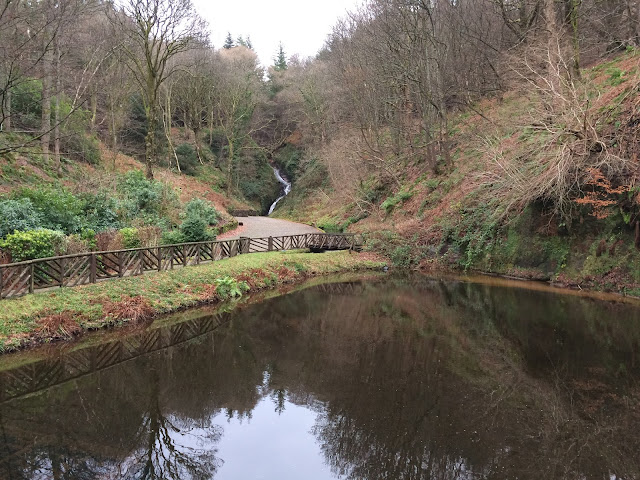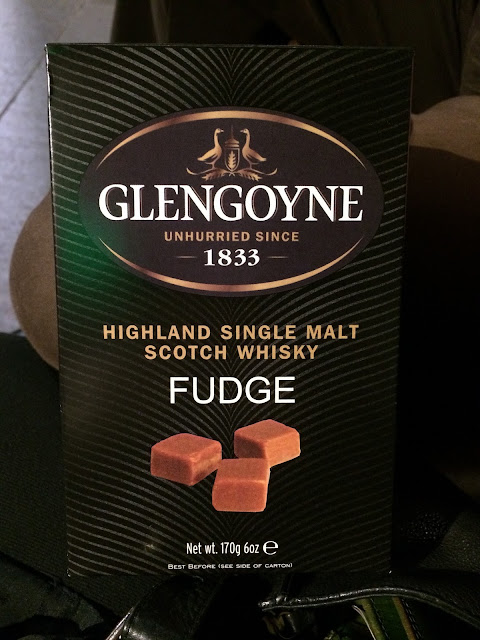It was near Hogmanay and we thought the place would be very quiet but it was still receiving steady flow of visitors whilst we were there. It was quite a fine day to visit, albeit being cloudy, but without snow or rain with temperature being around 5 or 6 degree. Considering it was the end of December, it was a perfect day to visit this place.
Apparently the founder of the today's Glengoyne Distillery began distilling illegally in 1820, then acquired the licence to distill at Glenguin of Burnfoot in 1833. The name then changed to Glengoyne in 1907.
We arrived by a taxi and Emily also kindly offered to pick us up afterwards so I thought I would also try a dram or two and perhaps I could appreciate the taste of whisky better after the tasting tour.
By the way, 'dram' is a Scottish word that came from Scottish Gaelic meaning simply 'drink' in English and is equivalent to 1/13 of a pint which is 43ml in measure.
We walked through the gate, passing by No.1 Warehouse to get to the reception in the back to start our tour.
We noticed some stacks of casks displayed with people's name plates. We later learned that these are the names of people who own/owned casks with Glengoyne Whisky in them, which no longer happens.
Tour started in a lovely lounge area with welcoming dram of Glengoyne 12 year old, followed by a introductory video about the distillery.
The tasting notes for 12 year old says - scents of lemon zest, coconut, honey and dried oak with tastes of toffee apples, ginger, orange and shortbread with finish of a hint of sherry, soft oak and cinnamon spice. Did I get any of these .... no... perhaps a bit of honey and oak maybe ....
We then went outside to the veranda where we could see the small distillery loch in the back. In older days, they used to use the water from this loch but now the water for making whisky comes from a much bigger reservoir behind the hill. They said that they still use the water from this distillery loch for cooling process during the distilling spirits.
Their website also informs me that a distillery manager named Cochran Cartwright drowns in this loch in 1899 - allegedly after one too many drams. Some says that Cochrain's ghost still haunts the grounds!
Unfortunately we are not allowed to take photographs from this point so I can only give you a quick summary of what involves in whisky distillation process. Main ingredients are barley, water and yeast. Malted barley (for the starch contained in the barley in sugar that will change into sprit in later process) is dried and grinded into coarse flour (called grist), which is mixed with hot water in the mash tun for brewing process. This process will change the starch in fermenting sugars and this sugared juice is called wort. Yeast is added to start the fermentation process, producing alcohol and carbon dioxide. At the end of this process, it is like a beer with approxiately 8% alcohol. Next process is the distillation to separate alcohol from water using copper pot stills which look like this ....
 |
| Souvenir pot still, anyone? |
There were no fermentation of distilling going on due to Christmas holiday when we were there however it was still interesting to see all these facilities.
Spirits during the second distillation, between 63 and 72% of alcohol will be casked. We were then shown to No. 1 Warehouse, which used to be the old barley kiln (see below with pagoda roof) in olden days.
Inside there are displays of varieties of casks and how those would affect the colour of the spirits during ageing process.
At Glengoyne Distillery they use oak from the forests of northern Spain, which is dried naturally by sun and air for three years. Once ready, each cask is hand-built to fill with sherry in Jerez, leaving to absorb its rich colour and flavouring for up to three years before it becomes ready to be emptied and delivered to the distillery to age their whisky over the next 10 to 18 years, thus taking the rich gold, amber and copper tones naturally from the wood. Wow, I sound like doing a sales pitch!
We were then shown to a private room to taste two award winning whiskies - 18 year old and 21 year old.
As we were the only one who opted for Gold Medal Parade tour, we had the guide and the room all to ourselves for this tasting.
First we tried Glengoyne 18 year old which won San Francisco World Spirits Competition 2014 and The Spirit Business Award 2014. The colour is medium gold. The tasting notes says that the nose has 'awash with red apple and ripe melon, heavenly and well rounded, drifting into hot porridge topped with brown sugar.' The taste is 'full bodied, round and rich, first macerated fruits, marzipan and walnuts; then warm spices, dry cocoa and lingering Seville marmalade' with 'long, warm and dry' finish. Wow, sounds wonderful, alas, I did not get any of these whilst my husband was throughly enjoying his dram, appreciating the aroma, taste and its finish in his mouth. I had another sip but I still did not get it so I gave the dram to my husband who appreciated well.
The next one is Glengoyne 21 year old which also won double gold San Francisco World Spirits Competition 2014. The tasting notes says, appearance is 'deep copper, meandering legs', nose has 'red apples, spicy strudel, toffee, sherry and dried fruits, Christmas cake in a glass' and its taste being 'lots of sherry, honey, oak with a developing aromatic sensation, ending with a heavenly cinnamon nip' with 'long, sherry, spicy, warm and dry' finish. This was really a special whisky, smelt wonderful. Spicy strudel? If you say so .... yet I still didn't get it. I don't think I have a nose for whisky at all. So I gave the dram to my husband who could appreciate much much more.
 |
| Cask strength - the far right bottle |
The only meaningful thing I got from the whole whisky tasting was that when you add a touch of water into a glass, it transpires the taste of whisky into a different level in flavours without diluting it. Such a clever drink indeed. I wish I could understand whisky as it would be so much fun and interesting if I can try whiskies from different regions within Scotland to really appreciate them.
According to The Scotch Malt Whisky Guide (http://www.scotchmaltwhisky.co.uk), each region produces distinct character of malt whiskies.
- Lowland Malt: light in colour with dry finish with certain sweet fruitiness to the flavour, and excellent as aperitif, e.g. Auchentoshan.
- Highland Malt: slight whiff of smokiness with a sweet start and dryish finish with a trace of saltiness, e.g Glenmorangie or Glengoyne.
- Islands Malt: slightly more peaty but its neatness is generally softer and sweeter than Islay ones with coastal feel to them, e.g. Highland Park.
- Islay Malt: where Islay surface is very flat, consisting largely of peat that has a huge influence on the flavour of the whiskies - very smoky and medicinal, salty and sea weedy with a dry finish - very acquired taste, e.g. Laphroaig
- Cambeltown Malt: full bodied with depth and slightly salty finish with hint of peat, e.g. Springbank.
- Speyside Malt: sweetest of all Scotch Whisky with either heavy and rich sherry flavour or complex light floral flavour, e.g. Glenfiddich.
Imagine you can get to try all these different whiskies in each region, how great that would be. I may need to go to some kind of lesson one day to understand Scotch Whisky properly, starting from Lowland Malt and when we retire, we could tour around Scotland to visit all these regions and see if I could get any of those tastes and flavours like toffee, Christmas pudding or oranges.
Anyway, the tour ended. Our tour guide, Gareth, was a wonderful and friendly guide and we enjoyed the tour very much. I did not had much of drams as I gave most of mine to my husband who actually appreciated and enjoyed much better whilst I opted to be satisfied with the angels share!
Anyway, whilst waiting for Emily to pick us up, we checked some merchandise at the shop.
 |
| 35 year old Glengoyne Whisky - £2,850 a bottle!!! |
Once Emily came, we all went to the back of the Distillery to admire the surroundings. It's not a big ground but lovely and peaceful.
Looking at these surroundings you could almost imagine people who engaged in illicit distillation in almost 200 years ago, away from the eyes of Customs and Excise.
The word Whisky comes from Gaelic word uiscel using meaning water whilst distilled alcohol was known in Latin as aqua vitae 'water of life'.
Slainte mhath (good health in Scottish Gaelic)!
That's all forks.



























No comments:
Post a Comment